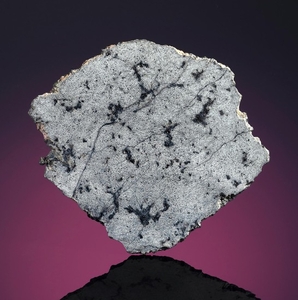ENTRAPPED MARTIAN ATMOSPHERE IN METEORITE— LARGE COMPLETE SLICE OF NWA 11057, Mars Rock – SNC Diabasic Shergottite Sahara Desert, Northwest Africa
Large inclusions of vesicle-rich black impact glass are scattered across this specimen along with transecting veins of impact melt. The exterior rim contains bright bronze-hued highlights, artifacts from the surface of the Sahara which bonded with the outer surface of the meteorite from which this slice is derived. This is a superior, large format, slice of a Mars rock. Modern cutting.
137 x 129 x 2 mm. (5⅓ x 5 x ⅛ in.) and 157.1 g. (⅓ lbs)
Specimens of the planet Mars are among the most exotic substances on Earth with less than 400 pounds known to exist. The delivery mechanism to Earth was an asteroid impact on Mars that ejected material off the Martian surface into an Earth-intersecting orbit. This is the 11,057th distinct meteorite to be recovered and classified by scientists after having been found in the Northwest Africa (NWA) region of the Sahara Desert. The determination of Martian origin is the result of research conducted by hundreds of scientists throughout the world. In addition to many arcane chemical and isotopic markers, most Martian meteorites are much younger than the 4½-billion-year age of the solar system — unlike meteorites from asteroids. The link to Mars was speculative until an analysis was conducted on the glassy inclusions of other suspected Martian meteorites. Within the glass were tiny bubbles of gas. The gas was analyzed and it matched perfectly with the signature of the Martian atmosphere as reported by NASA’s Viking Missions to Mars. This is a medium-grained igneous assemblage of predominantly zoned clinopyroxene and maskelynite with accessory ilmenite (containing rare inclusions of baddeleyite and K-bearing glass). The author of the scientific abstract on NWA 11057 is Dr. Anthony Irving, the world’s foremost classifier of planetary meteorites. The official classification of this meteorite appears in the 106th edition of the Meteorite Bulletin. The specimen of Mars offered here contains a tremendous amount of impact glass, some of which are likely to contain small bubbles of trapped Martian atmosphere.
The official classification of this lunar meteorite appears in the 106th edition of the Meteoritical Bulletin. The write-up was done by the world’s most renowned classifier of lunar meteorites, Dr. Anthony Irving, and a copy of the abstract and the write-up aaccompanies this offering.
Christie's would like to thank Dr. Alan E. Rubin at the Institute of Geophysics and Planetary Physics, University of California, Los Angeles for his assistance in preparing this catalog note.
View it on
Sale price
Estimate
Time, Location
Auction House
Large inclusions of vesicle-rich black impact glass are scattered across this specimen along with transecting veins of impact melt. The exterior rim contains bright bronze-hued highlights, artifacts from the surface of the Sahara which bonded with the outer surface of the meteorite from which this slice is derived. This is a superior, large format, slice of a Mars rock. Modern cutting.
137 x 129 x 2 mm. (5⅓ x 5 x ⅛ in.) and 157.1 g. (⅓ lbs)
Specimens of the planet Mars are among the most exotic substances on Earth with less than 400 pounds known to exist. The delivery mechanism to Earth was an asteroid impact on Mars that ejected material off the Martian surface into an Earth-intersecting orbit. This is the 11,057th distinct meteorite to be recovered and classified by scientists after having been found in the Northwest Africa (NWA) region of the Sahara Desert. The determination of Martian origin is the result of research conducted by hundreds of scientists throughout the world. In addition to many arcane chemical and isotopic markers, most Martian meteorites are much younger than the 4½-billion-year age of the solar system — unlike meteorites from asteroids. The link to Mars was speculative until an analysis was conducted on the glassy inclusions of other suspected Martian meteorites. Within the glass were tiny bubbles of gas. The gas was analyzed and it matched perfectly with the signature of the Martian atmosphere as reported by NASA’s Viking Missions to Mars. This is a medium-grained igneous assemblage of predominantly zoned clinopyroxene and maskelynite with accessory ilmenite (containing rare inclusions of baddeleyite and K-bearing glass). The author of the scientific abstract on NWA 11057 is Dr. Anthony Irving, the world’s foremost classifier of planetary meteorites. The official classification of this meteorite appears in the 106th edition of the Meteorite Bulletin. The specimen of Mars offered here contains a tremendous amount of impact glass, some of which are likely to contain small bubbles of trapped Martian atmosphere.
The official classification of this lunar meteorite appears in the 106th edition of the Meteoritical Bulletin. The write-up was done by the world’s most renowned classifier of lunar meteorites, Dr. Anthony Irving, and a copy of the abstract and the write-up aaccompanies this offering.
Christie's would like to thank Dr. Alan E. Rubin at the Institute of Geophysics and Planetary Physics, University of California, Los Angeles for his assistance in preparing this catalog note.



